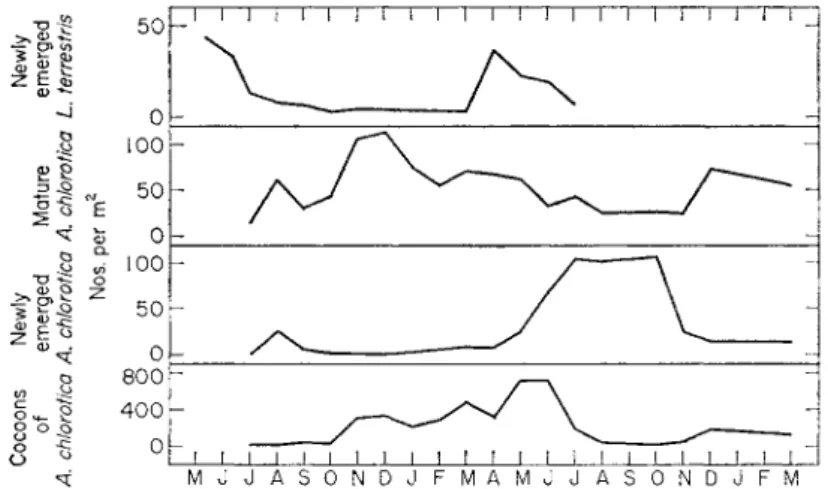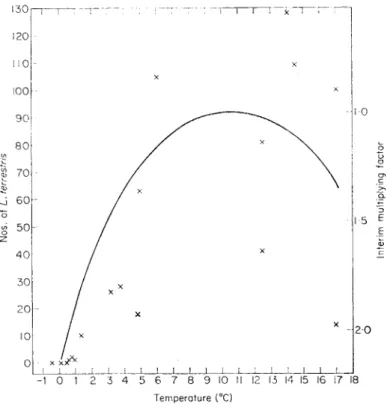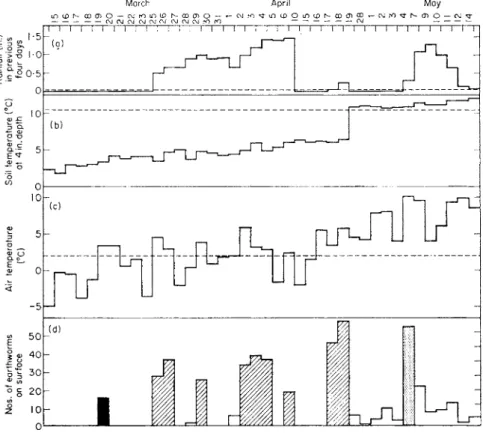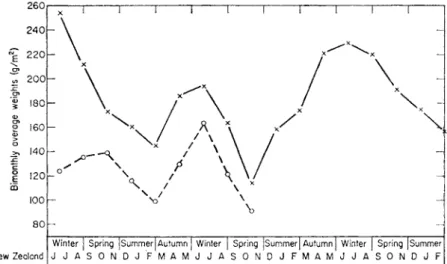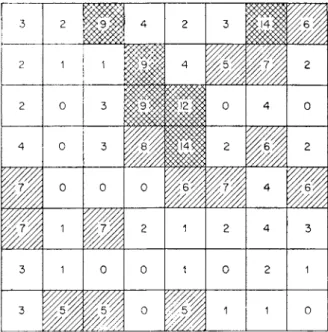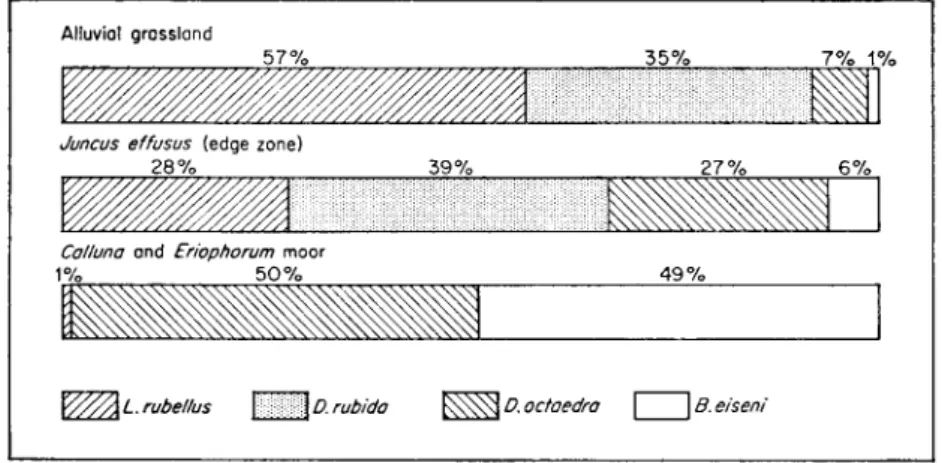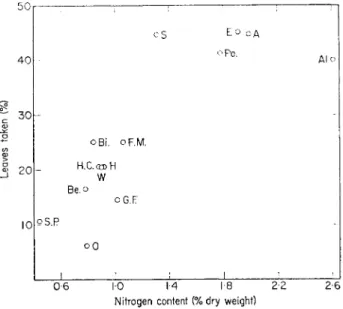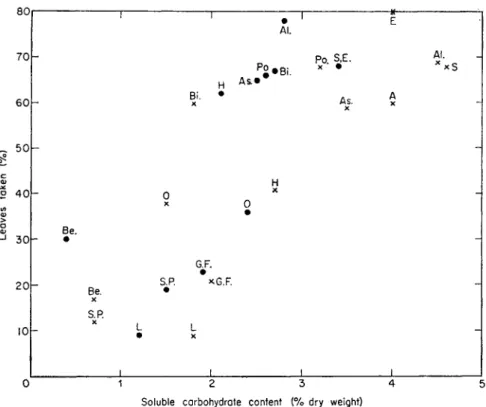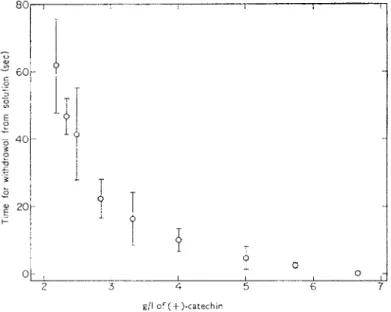Chapter 9
Lumbricidae
J. E. SATCHELL
Merlewood Research Station, Grange-over Sands Lancashire, England
I. Introduction 259 II. General Biology 260
A, Reproduction and Life History 262 B. Seasonal Activity in Relation to Soil Moisture, Temperature and
Food Resources 267 HI. Earthworm Populations—Biomass, Distribution and Regulation . . 272
A. Methods of Population Sampling 272
B. Biomass 272 C Population Aggregation 274
D. Species Distribution and Density 275 IV. Effects of Earthworms on Soil Structure 293
A. The Structural Stability of Earthworm Casts . . . . 2 9 3 B. The Effect of Burrows on Soil Aeration and Drainage . . 296
V. Consumption of Plant Litter by Earthworms 297 A. Comparison of Consumption by Laboratory and Field Populations 297
B. The Effect of Earthworms on Litter Disappearance . . . 300 VI. Effects of Earthworms on the Circulation of Plant Nutrients . . 302
A. Effects on Nitrogen Mineralization 302 B. Earthworm Metabolism and its Effect on the C:N Ratio of Soil
Organic Matter 305 VII. The Influence of Earthworms on Soil Micro-organisms . . . 3 1 3
A. Changes in Microbial Populations in the Earthworm Gut and
Faeces 313 B. Stimulation of Microbial Decomposition by Earthworm Activity 317
References 318 I. I N T R O D U C T I O N
The Lumbricidae is the characteristic Oligochaete family of the Palaearctic region. It comprises about 220 species and is a recent and dominant group possessing great powers of adaptation to new surroundings. About 19 species are common over the greater part of Europe and have been carried by man to many parts of the world, where they have locally replaced the indigenous earthworm fauna. In soils where they flourish they dominate the inverte- brate biomass and, because of their large size, their effect on the gross physical structure of their habitat is unique amongst the mesofauna.
As a classroom type of the Annelida, "the earthworm" is familiar to every
260 J. E. SATCHELL
biology student. Its basic biology is described in standard textbooks and is not repeated here. As classical subjects for laboratory experiment the lum- bricids have an extensive literature which was surveyed by J. L. Stephenson in his monograph The Oligochaeta, published in 1930. M. S. Laverack's The Physiology of Earthworms (1963) provides a critical survey of more recent work in the light of modern physiological concepts and a recent key to the British Lumbricidae is available in Gerard (1964).
II. G E N E R A L BIOLOGY
Although water is the main constituent of earthworms—about 80-90% of their fresh weight (Grant, 1955a)—the ability to withstand desiccation is one of the most remarkable features of their biology. Lumbricus terres tris can sur- vive losing 70% of the water content of its body, and Allolobophora chlorotica, 75% (Roots, 1956), and many species can withstand several months of drought in a quiescent state. Nevertheless, although the Lumbricidae are remarkably successful as a terrestrial group, they have a basically aquatic organization.
15 ·
10
1951 '52 '53 '54 '55 '56 '57 '58 '59 '60 '61 '62 '63
P
FIG. 1. Earthworm population density and summer rainfall in a Welsh pasture (Reynold- son, unpublished work).
Allolobophora caliginosa, A. chlorotica and A. rosea comprised 90% of the population.
-x—x-, rainfall (cm/month); — · — φ — , numbers of earthworms/m2.
They lack special respiratory organs and so must maintain a constantly moist body surface for gaseous exchange. Their main nitrogenous excretion is ammonia, which needs a copious hypotonie urine for its elimination. Loco- motion and burrowing depend on the hydrostatic pressure of the coelomic fluid and cannot proceed normally if the water content of the body falls by more than 18% (Wolf, 1940). Consequently, the avoidance of desiccation is a keystone in earthworm ecology (Fig. 1).
Evidence will be given later to suggest that competition for food amongst earthworms is often intense and that most of what is known of lumbricid
9. LUMBRICIDAE 261 behaviour and distribution may be interpreted in terms of these two basic requirements, water and food.
Except for species with specialized sub-aquatic habitats, the Lumbricidae fall into two main groups, those like Dendrobaena octaedra and Bimastos eiseni that live in surface organic horizons and ingest little mineral material, and those like Octolasium cyaneum and Allolobophora caliginosa that live predominantly in the mineral soil. The division is not absolute, for example L. terrestris feeds on plant remains drawn from the surface into its burrow and it also ingests soil; L. rubellus lives like L. terrestris in mull soils but in soils with raw humus is found only in the organic layers. Never- theless, there are distinctive differences between the two groups of species. In surface feeding species the body wall is deeply coloured with reddish pig- ments, identified from L. terrestris as protoporphyrin and protoporphyrin methyl ester (Laverack, 1960). Subterranean species lack this pigmentation and are predominantly pale in colour. Except for L. terrestris, which remains partly in its burrow while feeding, the surface feeders wander over the ground surface*, whereas subterranean species (Table I) rarely do so, and only when sexually mature.
TABLE
The proportions of pigmented and unpigmented Lumbricidae found in soil samples from limestone grassland and collected on the surface
at night (from Svendsen, 1957a)
Pigmented Unpigmented species species Soil samples 168 221 Free on the surface at night 103 25
The pigmentation has been supposed to protect the surface active species from damage by ultra-violet irradiation (Merker and Braunig, 1927) but Kalmus, Satchell and Bowen (1955) found that the unpigmented form of Allolobophora chlorotica was unaffected by ultra-violet irradiation several times greater than occurs in daylight. Moreover, L. terrestris, which is pig- mented, is crepuscular and nocturnal and so is unlikely to need protection
* This occurs during and after rainfall under appropriate temperature conditions and has been reported (Svendsen, 1957a) to take place in Pennine moorland equally in daylight and darkness. This seems inconsistent with what is known of the response to light of L. terrestris, which is photonegative to strong light and photopositive to light intensities below about 0-0018 metre candles (Hess, 1924) resulting in the restriction of surface feeding to the hours of dusk and darkness. However, unpigmented species, particularly O. cyaneum, which are strongly photonegative to all but the weakest light, are frequently seen in daylight on the surface after heavy rain. Some authors (Merker and Braunig, 1927; Merker, 1928; Nagano,
1934) have regarded this as a response to oxygen deficiency in the soil water, but Roots (1955) considered that water-avoiding reaction alone would explain the worms' behaviour after heavy rain.
262 J. E. SATCHELL
from ultra-violet irradiation. The close tonal match between the dorsal sur- face of pigmented earthworms and soil and dead leaves suggests that pig- mentation may be a cryptic adaptation to prédation by birds (cf. Southern,
1954). There is experimental evidence that the green pigmented form of A, chlorotica survives better than the unpigmented form when subjected to bird prédation (Satchell, unpublished work).
A. REPRODUCTION AND LIFE HISTORY
Reproduction: Reproduction in the Lumbricidae varies from strict cross breeding in most British Allolobophora and Lumbricus species to facultative parthenogenesis in Dendrobaena and obligate parthenogenesis in Octolasium, Eiseniella, Allolobophora rosea and Dendrobaena rubida f. tenuis (Muldal,
■o-S
> , ω ·£;
? Jr. <ι>
Φ β> ^ Q> -*-
- J . O
O 5 => -5
S *
^x» -£: . 0
slewly merge chloro
<
ω -y 0
fe_?
0 0 0
δ § ^:
ε
<υ û .
■ζ. ο
50
0 100 50 0 100 50 R00 0 4 0 0 0
FIG. 2. Seasonal abundance of A. chlorotica in "Pastures," Rothamsted 1958-60 (from Gerard, 1960) and of newly-emerged L. terrestris in Heaning Wood, Lanes., 1962-63.
1950). L. terrestris mates on the surface; other species mate below ground. So far as is known, mating occurs throughout the year except when soil condi- tions are unsuitable (see pp. 269-271) or the worms are in diapause.
Similarly, cocoon production occurs throughout the year when conditions are suitable. For example, Fig. 2 shows that the number of A. chlorotica cocoons in the soil increases from late summer until May-June, when they hatch faster than they are produced.
In many situations, particularly at the limits of their range, earthworm populations may be prevented by adverse moisture and temperature condi- tions from exploiting the available food resources fully. In less rigorous habitats competition for food appears to be normal. The fecundity of earth- worms depends greatly on the food supply (see p. 280), and this homeostatic mechanism regulates the abundance of competing populations. A population
Π I I Π Γ I τ^ι^τ π
9. LUMBRICIDAE 263 that is greatly decreased, e.g. by prolonged drought (see 1959 data in Fig. 1), may take up to 2 years to recover when conditions are favourable, but usually the reproductive potential is sufficient for populations to adjust rapidly to improved conditions. Table II shows the differing fecundity of
TABLE II
Number of cocoons produced per worm per annum in laboratory cultures (Evans and Guild, 1948)
Species Year
L. rubellus L. castaneus
D. subrubicunda D. mammalis A. caliginosa A. chlorotica A. nocturna A. longa A. rosea E. foetida O. cyaneum
1945 106
65
— 17 27 27 3 8
— —
—
1946 79
— 42
— 27 25
— — 8 11 13
lumbricid species kept in laboratory cultures, and although the data may bear little relation to fecundity in the field, there is a striking relationship between the numbers of cocoons produced by the different species and the severity of the environmental hazards they are likely to encounter in nature. For example, the deepest burrowing species (Fig. 3), A. nocturna, A. longa and O. cyaneum, which are most protected from desiccation, produced 3 to 13 cocoons in a year (Evans and Guild, 1948) ; L. terrestris, which also burrows deeply, produces a similar number of cocoons per annum. A. caliginosa and A. chlor otica, which inhabit the top-soil, produced 25 to 27 cocoons per annum; and L.
rubellus, L. castaneus and D. subrubicunda, which live at the soil surface and are most exposed to heat, drought and prédation, produced 42 to 106 cocoons in a year.
Moreover, fecundity depends greatly on soil humidity and temperature (Figs. 20 and 23), as does the incubation period of the cocoons. Cocoons of A.
chlorotica hatch under favourable moisture conditions in about 36 days at 20, 49 days at 15 and 112 days at 10° c (Gerard, 1960). For some species the range in incubation period is extremely large (Fig. 4). For example, Evans and Guild (1948) record that batches of A. caliginosa and L. castaneus cocoons, all laid within a fortnight, hatched in two distinct groups separated by 10 to 12 weeks of low winter temperatures. The physiology of incubation is not understood, but a flexible incubation period that enables a species to survive adverse seasons is clearly an advantage. Normally the factors that
264 J. E. SATCHELL
control cocoon production and incubation period in L. terrestris, L. castaneus and A. chlorotica, and probably other species, synchronize to produce pro- nounced peaks of emergence in the spring and early summer (Fig. 2), when the growth rate may be 3 to 4 times greater than at other times of the year (Satchell and Skellam, unpublished work).
Like incubation, the growth period from emergence to sexual maturity is flexible and depends on environmental conditions (Table III and Fig. 5).
For example, the periods recorded for A. chlorotica are 13 weeks at 18°c (Michon, 1954), 17 to 19 weeks at 15°c (Graff, 1953) and 29 to 42 weeks in an
L. ter re s tris
c;
1
Ci G
.C D o
o j Loam
Clay with flints J
FIG. 3. Vertical distribution of earthworms in a Rothamsted pasture (from Satchell, 1953).
unheated cellar (Evans and Guild, 1948). In woodlands near Merlewood Research Station, Lancashire, there is a peak emergence of this species in early summer, and the population contains the greatest proportion of adults
TABLE III
Growth period (days) from emergence to sexual maturity of Eisenia foetida kept at constant temperature (Michon, 1954)
Food 28° c 18°c Dung 46 59 Tilia leaves 62 91
9. LUMBRICIDAE 265 in the winter following. Development to sexual maturity therefore appears to take about 6 months. L. terrestris matures in these sites in about 1 year.
The breeding life of most lumbricids is probably quite short, rarely more than a few months, and much interrupted by unfavourable conditions (see
April \-
Sept.h
Cocoons deposited
1946 Young emerged
1947
Cocoons deposited 1946
Young emerged 1947
FIG. 4. Incubation periods of cocoons (adapted from Evans and Guild, 1948).
- o o-, incubation time in months, (a) L. castaneus\ (b) A. caliginosa. 6
p. 266). In the laboratory, individual specimens of E. foetida, L. terrestris and A. longa have been kept for 4^, 6 and 10£ years respectively (Korschelt, 1914), but these represent the ends of very skew longevity distributions. An average life of rather less than 2 years has been recorded for 10 common field species kept at 18°c, ranging from 15 months for A. chlorotica to 31 months
266 J. E. SATCHELL
for A. longa (Michon, 1954). The phenology of maturation, reproduction and senescence observed in these cultures (Fig. 5) differed from that of L. terrestris in cultures kept in the ground outdoors (Satchell, 1963) (Fig. 6). These worms became sexually mature at about 1 year, and about half survived at least 3
1000 n — i · 1 1 ' 1
O U I I ! I I _ J 10 100 2 0 0 3 0 0 4 0 0 5 0 0 6 0 0
Days
FIG. 5. Development of Dendrobaena subrubicunda at 18 and 9°c (from Michon, 1954).
FIG. 6. Growth increment and mortality ( ) of L. terrestris reared outdoors.
9. LUMBRICIDAE 267 years showing no sign of senescence. The mortality rate was approximately constant throughout, individuals losing weight before death. The causes of death are unknown, but some individuals which lost weight contained hyphae of a phycomycete in a dense web surrounding the intestine. Growth rate studies and size class frequencies in field populations suggest that the average life of this species is about 15 months, although a few individuals may survive for 8 or 9 years.
B. SEASONAL ACTIVITY IN RELATION TO SOIL MOISTURE, TEMPERATURE AND FOOD RESOURCES
Earthworm activity in the field is markedly seasonal. The production of faeces in the form of wormcasts on the soil surface shows marked maxima in spring and autumn and may cease completely at other times of the year (Fig. 7). Similarly, the numbers of earthworms collected by vermifuge
•σ ? 70
FIG. 7. Seasonal variation in worm cast production and numbers of earthworms extracted by permanganate sampling, Great Field, Rothamsted (redrawn from Evans and Guild,
1947).
sampling, which depends on the activity of the worms to bring them to the soil surface, tend to show spring and autumn maxima (Fig. 7). In both these examples activity has been shown to be correlated with soil tempera- ture and soil moisture (Evans and Guild, 1947), but the response to these factors varies considerably between species,
268 J. E. SATCHELL
7. Seasonal activity in L. terrestris
For L. terrestris, the relationship between activity and soil temperature can be represented approximately by the curve shown in Fig. 8. This is derived from the numbers of worms collected from woodland sites near Merlewood by a standardized sampling procedure using dilute formaldehyde as an ex- pellant. It is based on a large number of samples taken over a period of 2
130 120 MO 100 90 80 1 70
-CD
J 60
40 30 20 10 0
- 1 0 1 2 3 4 5 6 7 8 9 I0 II I2 Γ3 I4 I5 I6 I7 I8 Temperature (°C)
FIG. 8. Motor activity of L. terrestris in relation to temperature, x, numbers of L.
terrestris on the surface of a garden plot 17 m2 (data from Kollmansperger, 1955).
Curve indicates temperature correction factor for estimating L. terrestris biomass from weights of worms expelled by formaldehyde (see text).
years, and is corrected for variations in population density. The optimum soil temperature (at a depth of 10 cm) for response to the expellant appears to be about 10-5° c.
The numbers of worms found on the soil surface at night can also be used as an index of activity, provided population density is constant. In Fig. 8 the numbers of worms active on the surface of a garden plot in Germany and the prevailing ground temperatures are shown (Kollmannsperger, 1955), with the formaldehyde sampling temperature curve superimposed. The data,
9. LUMBRICIDAE 269 which are selected to include only nights after recent rain, are consistent with the curve and suggest an optimum temperature of about 10-5° c for surface activity. Figure 9 shows similar data for earthworms active on a close mown lawn at Merlewood.* They represent the worms, mainly L. terrestris, seen on a permanently marked-out area of 12 m2 during counts begun at 1 a.m. on 40 nights in March-May 1962. The records suggest that the nights most
March April May in Φ Ν (BCD O - C\J rO U~> 10 N C C C D O - ^ N K ) ^ m U ) O i n t D N C 0 C n C 0 ' - 0 J K ) ^ N ( T ) O - C V j q ·
c\jc\J<\jc\JC\jc\JCMC\ic\irorO — — — — c\j — Τ Ί — I I I I I I I I ! I ί~Ι Γ Ί I I I I ! I I I I I—I ! ! I I 1 I I I 1 I 1 I I
FIG. 9. Surface activity of L. terrestris in relation to rainfall and temperature.
(a) Rainfall (in) in previous four days; (b) soil temperature (°c) at 4 in depth; (c) air temperature (°c); (d) numbers of earthworms on surface: ■, temperature rise after 7 nights below zero; H, air temperature above 2°c, soil temperature below 10-5°c, rainfall during previous 4 days; H, rainfall following 12 rainless days.
suitable for earthworm activity were those when grass air-temperatures were above 2°c, when soil temperatures did not exceed 10-5° c and when there had been some rain within the previous 4 days. All the main peaks of activity occurred in such conditions except two, and both of those followed long periods of inactivity. If it is sufficiently hungry, L. terrestris will apparently come out to feed when it would not otherwise be active on the surface. The
* Recorded by J. M. Nelson.
270 J. E. SATCHELL
number of leaves buried by L. terrestris kept at constant temperature (Table IV) also suggests that the optimum temperature for motor activity is near 10° c.
This is about 2*5° c less than the optimum found by Laverack (1961a) (Fig.
10) for segmental nerve preparations for L. terrestris, but the difference may be accounted for by cerebral or synaptic inhibition of motor response.
TABLE IV
Number of leaves buried by 20 L. terrestris in 4 months at constant temperatures (Raw, unpublished data)
Temperature (°c) 0 5 10 15 No. of leaves buried 0 178 204 174
2 5 0 r
2 0 0
150
50
10 20 Temperature (°C)
30
FIG. 10. Graph showing steady rate curve of nervous activity for a range of temperatures.
The number of impulses rises towards an optimum at 13°c and then falls as the temperature increases further (from Laverack, 1961a).
The surprisingly low level of the optimum temperature for activity raises questions as to its ecological significance. It can be of no importance as a protection against heat death because the upper lethal temperature for L.
terrestris, 28° c (Wolf, 1938a), is unlikely to be encountered by earthworms in nature. The negative phototaxis of L. terrestris restricts it to crepuscular and nocturnal surface activity, and its deep burrows protect it from the hazards
9. LUMBRICTOAE 271 of desiccation in the topsoil, encountered by many species. Moreover, earthworms move away from drying air irrespective of the temperature (Parker and Parshley, 1911; Wolf, 1938b).
Except in very cold weather and during nocturnal surface activity, L.
terrestris generally occupies the topsoil where, in temperate forests, the temperature rarely exceeds 10-5° c except between mid-May and October (Fig. 32). At this season food supplies from one leaf fall have virtually ended and have not yet been replenished from the next (see Fig. 29). If the respira- tion rate of L. terrestris increased with increasing temperature during this period, death by starvation could follow. The basal metabolic rate of L.
terrestris increases with rising temperature almost to the thermal death point (Pomerat and Zarrow, 1936), but the reduction of motor activity at tempera- tures above 10-5° c may counteract this (see pp. 268) and could actually decrease metabolism. The control of motor activity by ambient temperature can thus be regarded as an indirect mechanism that limits oxidative meta- bolism at a time when food is scarce.
2. Seasonal activity in Allolobophora spp.
The activity of sexually mature Allolobophora longa and A, nocturna is interrupted by summer diapause. In nature this begins in May, when soil temperatures are rising and soil moisture is falling. The worm stops feeding, lines a small cell with mucus, rolls into a ball and enters an inactive state dur- ing which it loses its secondary sexual characters. It cannot be aroused by changes in soil temperature or humidity, but diapause ends spontaneously in late September or October. Michon (1954) found that diapause did not occur in worms reared at about 9° c with adequate food and soil moisture but more recent work (Doeksen and van Wingerden, 1964) has not confirmed this.
Diapause contrasts with the quiescent state which occurs in immature specimens and also in A, chlorotica, A. caliginosa and A. rosea (Evans and Guild, 1947), when the worms roll up into a ball as the soil becomes too cold or too dry (Table V) and become active again immediately soil conditions become favourable. The ecological significance of this difference is not under- stood. There is considerable disagreement in the reports of various authors
TABLE v
Percentage of Allolobophora spp. in aestivation in an irrigated and a covered plot. Rothamsted 1959-60 (Adapted from Gerard, 1960)
July Aug. Nov. Feb. May
% Aestivating
Irrigated plot 3-8 0 0 0 6-3 Covered plot 100 100 28-5 0 48-1
% Soil Moisture (0-20 cms)
Irrigated plot 18-2 21-2 23-7 23-6 23-2 Covered plot 11-5 10-2 100 18-3 9-4
272 J. E. SATCHELL
(Avel, 1929; Evans and Guild, 1947; Michon, 1957; Doeksen and van Wingerden, 1964; Doeksen, 1964) on details of the behaviour of a number of species, and the subject requires further study, particularly of the neuro- secretory mechanisms involved.
Fig. 7 shows seasonal changes in wormcast production by A. longa and A. nocturna.
III. E A R T H W O R M P O P U L A T I O N S —
BIOMASS, D I S T R I B U T I O N A N D R E G U L A T I O N
A. METHODS OF POPULATION SAMPLING
Of the numerous methods used to sample earthworm populations, none are equally suitable for all species and all habitats. Evans and Guild (1947), in their pioneering studies on the earthworm populations of agricultural soils in Britain, used potassium permanganate solution to expel worms from the soil, a method limited by the penetration of the solution and the variable response of the earthworms to it. Sorting soil samples by hand is a more efficient procedure for soils that can be easily crumbled (Svendsen, 1955b), but most specimens less than 2 cm long are missed (Nelson and Satchell, 1962). For sampling small species, such as Eiseniella tetraedra, in wet, matted hill grassland, Raw (1960) used a method of flotation in magnesium sulphate solution which extracted more than twice the number found by hand sorting. Hand sorting is also impracticable for sampling L. terrestris, which when disturbed retreats down its burrow a metre or more deep. The discovery of formaldehyde solution as an expellant for this species (Raw, 1959) and the development of a method of biomass estimation which allows for the effect of soil temperature on the proportion of the population expelled (Satchell, 1963), has opened up the study of this important species in soil biology.
B. BIOMASS
Estimates of earthworm biomass (Table VI) based on formaldehyde sampling, approximately 100 to 250 g/m2, suggest that the weight of earth- worms in mull sites where L. terrestris is present is considerably greater than earlier methods indicated. In particular, Bornebusch's (1930) estimate of 61 g/m2, which is much quoted in comparative studies of energy turnover by soil fauna, is much too low to be typical of woodland mull. Present estimates suggest that the earthworm biomass of grassland and woodland are similar on similar soils. Lower weights are found in arable land, but they can exceed 100 g/m2 in fields heavily dressed with dung (Raw, 1961a). Estimates of up to 5 g/m2 for woodland raw humus and acid moorland sites (Table VI) indicate that the earthworm fauna there differs from that of other habitats and lacks the large, deep burrowing species.
All the above figures are subject to large standard errors arising from seasonal and spatial variation. In a mixed population of A. caliginosa and
TABLE VI
Numbers and weights of earthworms in various habitats
Eriophorwn moor Calluna moor
Picea raw humus (2 sites) Fagus raw humus (2 sites) Pseudotsuga raw humus Picea mull
Fagus mull (3 sites) Quercus mull Mixed wood mull Mixed wood mull (2 sites) Apple orchards under grass
(23 plots)
Apple orchards under arable cultivation (4 plots) Arable land
Arable land Arable land
Arable land (4 sets of plots) Base rich grassland (2 sites) Base rich grassland (2 sites) Base rich grassland (2 sites)
No./m2 001 01-0-5
18-31 23-81 101 14 73-177
122 78^93 157 25-500 848 13-30
196 287 220 146 389^70 481-524 390
g/m2
0-9-1-5 1-2-5-4 4-7 51 5-9-54
61 148-162* 40
11-122 287 11-23
153 48 76 50-106 50 52-110t 112-120 56
Locality Moor House,
Westmorland Moor House,
Westmorland Denmark Denmark Bangor, N. Wales Denmark Denmark Denmark Bangor, N. Wales Lake District Holland Wisbech, Cambs.
Holland Wisbech, Cambs.
Germany Bardsey Island Bangor, N. Wales Rothamsted Moor House,
Westmorland Bardsey Island Bangor, N. Wales
Sampling method Dung baiting Dung baiting Tullgren funnels Tullgren funnels Hand sorting
Tullgren funnels and hand sorting
Tullgren funnels and hand sorting
Tullgren funnels and hand sorting
Hand sorting Formaldehyde Hand sorting
Hand sorting and formal- dehyde
Hand sorting
Hand sorting and formal- dehyde
Wet sieving Hand sorting Hand sorting Formaldehyde Hand sorting Hand sorting Hand sorting
Authority Svendsen (1957b) Svendsen (1957b) Bornebusch (1930) Bornebusch (1930) Reynoldson (1955) Bornebusch (1930) Bornebusch (1930) Bornebusch (1930) Reynoldson (1955) Satchell (unpublished) Van Rhee and Nathans Raw (1959) [(1961) Van Rhee and Nathans Raw (1959) [(1961) Krüger (1952)
Reynoldson et al. (1955) Reynoldson (1955) Raw (1961a) Svendsen (1957b) Reynoldson et al (1955) Reynoldson (1955)
* Yearly averages corrected for temperature variation.
t L. terrestris is uncommon on these sites. Only 1 m2 was sampled for each estimate.
274 J. E. SATCHELL
L. rubellus in a New Zealand pasture the weight of earthworms found by Waters (1955) varied, during 2\ years monthly sampling, between approxi- mately 140 g/m2 in the summer to about 269 to 324 g/m2 in the winter (Fig.
11). A similar seasonal fluctuation in the biomass of L. terrestris occurred in woodland mulls near Merlewood (Fig. 11).
£ O U
2 4 0
*£ 2 2 0 u, 2 0 0 '% 180
ω 2 160
α>
>
o >, 140
1 120
ω 100
8 0
New Zealand Merlewood
π;—i 1 ι ι r- - \ - \
X
- \
- \ / \
x / Λ v / \ \
- --
Winter j Spring |Surnmer| Autumn | Winter | Spring J J A S O N D J F M A M J J A S O N J F M A M J J A S O N D J F M A M J
1 1 1
1
x^y 1
1 1
Summer | Autumn D J F M A M
1 ι
-
^ * x —
\ -
\ -
\
— - - -
Winter Spring [Summer J J A S O N D J F
FIG. 11. Seasonal variation of earthworm biomass. -x-x-, A. caliginosa (1951-54, New Zealand; from Waters, 1955); - o — o - , L. terrestris (1960-61, Merlewood; Satchell,
unpublished work).
C. POPULATION AGGREGATION
On one of these sites near Merlewood 10 quadrats, each 0-5 m2, were sampled by the formaldehyde method on each of 31 occasions. On one occasion the biomass of L. terrestris in individual quadrats ranged from 24 to 113 g. The standard error for the 10 samples varied on the 31 occasions between 6 and 17% of the mean.
The very patchy distribution which these figures reflect is typical of earth- worm distribution generally. It is common amongst such species as L.
castaneus (Fig. 12) which roam over the ground surface and aggregate under dung or similar localized food sources. It also occurs, however, where there is no particular concentration of food as a result of localized concentrations of cocoons. L. terrestris, for example, deposits its cocoons in the topsoil near the mouth of its burrow so that a "family" group is formed when the cocoons hatch in the spring. In species such as L. castaneus, with a marked seasonal abundance, the spatial distribution passes from a highly aggregated phase in the early summer when the population consists mainly of immature worms, through an intermediate phase when the aggregation is weakened by dis- persal and mortality to a winter phase when the population is low, predomi- nantly adult and randomly distributed (Satchell, 1955).
9. LUMBRICIDAE 275 D. SPECIES DISTRIBUTION AND DENSITY REGULATION
Unless saline or very deficient in organic matter, few soils in the temperate zone are incapable of supporting some species of earthworm. Barley (1961) expresses this in the working rule that where temperate grasses can grow, some species of earthworm can also grow. Many factors affect their distribution, the physical and chemical characteristics of the soil, the type of vegetation, and land management, but in most soils the primary factors that determine the population are the supplies of available water and food.
FIG. 12. Distribution of L. castaneus in a quadrat 8 x 8 yd (approx. 53-5 m2). H, more than 8 L. castaneus ly à2 \ H, 5-8 L. castaneus/yd2; D, less than 5 L. castaneus/yd2. 1. Distribution in mull and mor
Table VII shows the distribution of some common earthworm species collected from some Lake District woodlands by hand sorting. The five mull sites are on base rich soils overlying carboniferous limestone, the sites with mor humus, which is of a moder type, overlie base poor slates and shales of the Bannisdale series. Table VIII, taken from Guild (1948), shows the earth- worm distribution in a similarly contrasting pair of sites under rich pasture and moorland herbage. In the mull sites, about 8 characteristic species are found, of which three, L. terrestris, A, longa, O. cyaneum, are large worms several grams in weight. In the moder or peaty sites, rarely more than 4 species occur, all are less than 1 gram weight and the largest, L. rubellus, is much less
TABLE VU
Distribution of Lumbricidae in 10 Lake District woodlands
pH of litter pH at 15 cm A. rosea A. longa A. caliginosa A. chlorotica Octolasium cyaneum L. castaneus L. ter res tri s L. rube I I us D. rubida agg.
D. octaedra Bimastos eiseni
( Ye 6-6 80
X
X X X X X
w 7-5 6-7
X X
X X X
X
Mull sites
A
Sycamore 5-9 4-2 6-3
X X X X X X X
5-4
X X X X X X X X
Ï
ei
5-8X X X X X X X X X
Hazel (
A
4-5 3-7
X X
X X
4-3 3-7
X
X X
X X
Mor sites
Λ
Birch 4-3 3-3
X X X X
Oak 4 1 4 0
X
X X
Spruce ^
4 1 3-9
X X
Average field (g
size of mature . specimens fresh wt.)
0-41 2-29 0-47 0-40 1-98 0-25 5-58 0-75 0-20 013 0-25
>
H Ω X m
9. LUMBRICIDAE 277
TABLE VIII
Species composition of two earthworm populations sampled by the permanganate method (from Guild, 1948)
Species
A. longa A. chlorotica A. caliginosa A. rosea O. cyaneum L. ter re st ris L. castaneus L. rubellus D. rubida D. octaedra B. eiseni
Good quality pasture with much clover
(No./m2) 0-2 1-2 19-5 4.4 1-4 5-8 8-2 15-3 0 1 1-3
—
Acid peaty soil with coarse herbage and
heather (No./m2)
— —
— — 0 1 0 1 5-3 2 0 1-8 3-1
abundant than in mull sites. Under increasingly eutrophic conditions, L.
rubellus and species of the D. rubida complex decrease until only D. octaedra, and B. eiseni remain (Fig. 13) as the characteristic species of such extreme habitats as Calluna heath and conifer mor. It is interesting that although these species are adapted to mor sites and are most abundant there, their total bio- mass is small despite the abundant energy supplies present in the organic matter. Although it is commonly stressed that a mor fauna contains few
Alluvial grassland 5 7 %
Calluna and Eriophorum moor
1 % 5 0 %
L. rubellus
3 5 % 7% 1%
Juncus
Ü
effusus (e 2 8 %lilt in
dge zone) 3 9 % ^HH
2 7 %^n
6 %49%
D. rubida D. octaedra \ \ B. eiseni
FIG. 13. The relative proportions of 4 species of lumbricids found aggregated in sheep dung on different vegetation types on Moor House National Nature Reserve (from Cragg, 1961).
278 J. E. SATCHELL
species, there are many species of enchytraeids, microarthropods, larval Diptera and other groups adapted to mor conditions. The fact that organic horizons persist despite their presence shows that they, and the microflora on which many of them feed, are physiologically unable to fully exploit mor forming litter as food. Handley (1954) suggests that the organic nitrogenous material in mor is less easily digestible than that in mull.
2. Food as a population determinant
(a) The effect of added food supplies on field populations. It has already been stated that competition for food is a primary population determinant. One form of evidence for this is the population increase which occurs when food is supplied experimentally in the field. Examples from arable land, grassland and heath are given in Table IX. The first, Broadbalk, is under continuous wheat cropping, and the earthworm population of the plot that receives 14 tons (approx. 35 m. tons/ha) of farmyard manure per acre annually is 3 to 4 times as great as that on an unmanured plot. On Park Grass, a permanent mowing meadow, the earthworm population of a plot receiving 14 tons of farmyard manure and 6 cwt of guano (0-75 m. tons/ha) per acre every fourth year was, in 1952, three times greater than that of an unmanured plot. On Silpho Moor, an acid Callunetum, occupied almost solely by Bimastos eiseni, 8 years of applying birch litter to the heather at rates simulating natural leaf fall increased the population from less than 1 worm per 20 m2 to between 1 and 5 worms/m2.
(b) Nitrogen as a limiting food constituent. In the Silpho Moor experiment the nitrogen content of the birch litter was 2 to 3 times that of the Calluna litter, and the treated plots on Broadbalk and Park Grass at Rothamsted received heavy dressings of organic nitrogen. The response of the earthworm populations is consistent with much additional evidence that points to the importance of available protein in determining earthworm distribution and abundance.
Barley (1959) and Evans and Guild (1948) have shown that in laboratory cultures earthworms fed on nitrogen rich diets grow more (Table X) and produce more cocoons (Table XI) than worms fed on nitrogen poor diets.
Moreover, estimates of the nitrogen requirements of field populations suggest that protein supplies limit earthworm abundance. The amount of nitrogen excreted annually by a population of L. terrestris in Merlewood Lodge Wood, a Lake District ash-oak wood, is calculated as being about 33 kg/ha (p. 304). The amount of nitrogen available to this population has not been determined but, by analogy with similar woodlands, the annual production of tree litter is likely to be about 3,000 kg/ha with an average nitrogen content of about 1-5% and that of the ground flora about 8 kg/ha of nitro- gen. On this basis the total nitrogen content of the annual litter production from trees and herbage would be about 50 kg/ha, which is about one-third more than the estimate of the amount excreted annually by the L. terrestris population.
TABLE IX
Earthworm populations of plots treated with organic materials and control plots (No./m2)
1. Arable Broadbalk, Rothamsted (from A. C. Evans, unpublished work)
Control Dung No. (all species) 74-1 271-8 Weight (all species (g/m2) 5 0 50-3
Barnfield, Rothamsted (from Raw, 1961)
g/m2 (all species) Inorganic nitrogen fertilizer Control Dung NH3SO4 2-5 1061 NaN03 ( + rape cake) 24-1 78-8
NaN03 10-2 62-4
None 3-9 49-5
2. Grassland Park Grass, Rothamsted
(from
A. caliginosa A. nocturna A. chlorotica A. rosea L. castaneus L. terrestris O. cyaneum Total
Satchell, 1955)
Control 2-9 1-3 100 1-6 160 131 51-8 6-9
Dung 18-9 80 21-3 0 59-6 22-5 24-5 154-8
3. Heather Moor Silpho Moor, N. Yorkshire (from Satchell, unpublished
work)
Control B. eiseni
Replicate 1 0 Replicate 2 0 Replicate 3 0 Replicate 4 0
Birch Litter
30 1-4 0-6 5-4
280 J. E. SATCHELL
However, L. terrestris ingests, besides litter, a considerable amount of soil.
Specimens of various sizes taken from Merlewood Lodge Wood population in March 1961 contained 100 mg of soil (oven dry wt.) per gram body weight.
In this species food passes through the gut in about 20 (Parle, 1963b) —24 hours (Satchell, unpublished) so the rate of ingestion appears to be about 100 to 120 mg/g per day. This will of course vary with soil temperature and internal factors affecting the metabolic rate, but if it were maintained for 200 days in a year, the total annual soil intake by the population which had a
TABLE x
Change in body weight of A. caliginosa when fed for 40 days on various diets (from Barley, 1959)
Sandy loam soil Phalaris tuberosa roots Phalaris tuberosa leaves Clover roots
Clover leaves Dung on surface Dung incorporated
% N content of diet
004 0-8 2 0 2-6 4-5 3-3
TABLE XI
% Wt. change in worms
- 5 3 - 2 6 - 2 6 1-18 - 2 + 71 + 111
The cocoon production of two species of earthworms on various types of organic matter (from Evans and Guild, 1948)
Mean no. of cocoons produced by 5 earthworms Organic matter
Fodder Oat straw
Bullock droppings Sheep droppings
in 3 months A. chlorotica
0-8 1-4 12-4 140
L. castaneus 120 9-4 73-2 760
mean biomass of 120 g/m2 would be about 2,640 g/m2. The nitrogen content of the soil at 10 cm depth in Merlewood Lodge Wood is 0-46% (oven dry wt.), so the amount of nitrogen ingested in soil would be about 121 kg/ha. The total nitrogen available to the population from ingested soil and the entire leaf fall would therefore be about 170 kg/ha. Barley (1959) has shown that of the insoluble nitrogen ingested by A. caliginosa, 6-4% is excreted in soluble metabolized forms. If a similar proportion of the ingested organic nitrogen is metabolized by L. terrestris, and if the food materials were ingested only
9. LUMBRICIDAE 281 once in one year, then the total nitrogen excreted annually would be about 11 kg/ha, which is only one-third of that estimated from the excretion data referred to on p. 304. It may be thatL. terrestris digests protein more efficiently than A. caliginosa, but even if it were three times as efficient it would still need the whole of the woodland's litter output to balance its nitrogen ex- cretion rate. As there are other competitors for the litter, the demand must be met by selective feeding on some additional richer source of nitrogen. The soil organic matter of a woodland mull (Heaning Wood) similar to that in Merlewood Lodge Wood has a nitrogen content of 4-9% (Howard, personal communication) and although it can only be inferred that this forms an important nutrient resource for L. terrestris, there is substantial evidence that earthworms feed selectively on materials with a high nitrogen content.
(c) Food selection. Lumbricus terrestris, L. rubellus, A. longa, A. caliginosa, A. rosea, E. foetida and D. octaedra all show ability to distinguish between different kinds of litter (Lindquist, 1941). Food selection has been studied mainly in L. terrestris, which preferentially selects the leaves it draws into its burrows when offered a choice of different kinds (Table XII). In general,
TABLE xn
Order of preference of L. terrestris for leaves of different plant species (from Bornebusch, 1953)
(i) Mercurialis perennis, Urtica dioica, Oxalis acetosella, Agrostis sp., Sambucus nigra
(ii) Crataegus sp., Alnus glutinosa, Ulmus sp., Fraxinus excelsior, Prunus padus, Coryllus avellana, Betula sp., Acerpseudoplatanus, Carpinus betulus, Ribes sp.
(iii) Prunus serotina, Fagus sylvatica, Quer eus robur s.l., Q. borealis (iv) Abies alba, Pseudotsuga taxifolia
(v) Pinus mugo, P. sylvestris, P. nigra var. austriaca (vi) Picea abies, Larix decidua, L. leptolepis
leaves of mull species such as ash or Mercurialis are preferred to those of oak or beech or conifer needles. Darwin (1881) ascribed the order of selection to the shape and texture of the leaves, but in choice experiments where the effect of leaf shape is removed by using uniform-sized leaf discs or short lengths of conifer needle the order of selection is little changed. Wittich (1953) observed that protein rich litters are more readily taken than litters containing less protein, and this is supported by other experiments showing a correlation between the palatability of various litters and their nitrogen content (Fig.
14). However, litters with a high nitrogen content generally also have a high sugar content (Fig. 15) and, as earthworms are capable of detecting sweet tasting substances (Mangold, 1953; Laverack, 1960), this may explain their selection of protein-rich litter.
The palatability of litter may be much increased by a short period of
282 J. E. SATCHELL
weathering (Table XIII), and this may result from the breakdown of certain distasteful polyphenolic substances (Fig. 16). Brown, Love and Handley (1963) have recently shown that leaves of spruce, larch, beech and oak, which all produce unpalatable litter, contain condensed tannins which are absent
50
40
^ 3 0 -
* 20
10
~ : |
OS
oßi. oF.M.
H.C.(n>H W Be.o
oG.F
bs.P oo
1 ! ! 1
1 : E ° oA
oPo.
1 L_
Al.o
-i
0-6 10 14 18 Nitrogen content (% dry weight)
2 2 2-6
FIG. 14. Palatability of litter in relation to its nitrogen content.
A, Ash ; Al, Alder; Be, Beech; Bi, Birch; E, Elder; F, Giant Fir; F.M, Field Maple ; H, Hazel ; H.C, Horse Chesnut; O, Oak; P, Scots Pine; Po, Poplar; S, Sycamore; W, Walnut.
from Mercurialis, nettle, elderberry, ash and Wych elm which are all highly palatable to earthworms. Moreover, it can be shown (Fig. 17) that (+)- catechin, a commonly occurring leaf polyphenol, is repellant to L. terrestris, which withdraws from solutions of (+)-catechin at speeds directly related to their concentration.
TABLE XIII
Number of leaf discs removed from the soil surface by L. terrestris in laboratory experiments (Satchell, unpublished work)
(6 discs of each kind given nightly for 11 nights) Duration
of weathering
after leaf fall Beech Oak Hazel Birch 6 weeks —
12 weeks
57 80 88
59 74 90
77 89 98
87 92 101
9. LUMBRICIDAE 283
The increased palatability of oak litter after weathering appears to result from microbial activity. In selection experiments with L. terrestris (Table XIV), fresh oak litter discs kept in running tap water for 14 days were not taken in significantly greater numbers than untreated discs, but their palata- bility was increased considerably by incubation in water at room temperature
_ 50 σ 4 0
2 3 Soluble carbohydrate content (% dry weight)
FIG. 15. Palatability of litter in relation to its soluble carbohydrate content. Percentage of leaf discs and conifer needles removed from the soil surface by L. terrestris in laboratory
experiments.
Six discs or needle lengths of each kind given nightly for 33 nights.
x, Fresh litter. •Weathered litter; As, Aspen; L. Larch. For other abbreviations see Fig. 14.
for 2 weeks following exposure outdoors for 48 hours. It is known that the so-called white rot fungi produce enzymes capable of oxidizing phenols and that Pénicillium solitum and Aspergillus niger can decompose substances such as (+)-catechin (Bocks, Brown and Handley, 1963) and it may be that related microbial enzyme systems degrade the leaf constituents unpalatable to earth- worms.
3. The response of earthworms to soil acidity
The distribution of earthworms in relation to mull and mor (Tables VI, VII and VIII) appears to be controlled by their response to the pH of their
284 J. E. SATCHELL 100
^ 60
4 0
ί 1
- V * ο!·
•A *
· · •
Hi
-
Ί ! I
l I
•
•
I .... I
i i î — i
•o, J
! I l " I 0 2 4 6 8 I0 I2 I4 Total polyhydric phenols as phenol ( 5 0 % acetone water extraction) % dry weight
FIG. 16. Palatability of litter in relation to phenolic content. 1, fresh litter; 2, litter weathered for 6 weeks; 3, litter weathered for 12 weeks. For other abbreviations see Fig. 14.
8 0
6 0
40h
— i —
C
-
>
l l.
-
"I 1 - ■
)
î {
1 1
l ■ 1 I
-
° I"
g/l of ( + )-catechin
FIG. 17. Reaction of L. terrestris to aqueous solutions of ( + )-catechin. Means of 5 repli- cates, and 95% confidence limits.
9. LUMBRICIDAE 285
TABLE XIV
Selection by L. terrestris of leached and incubated oak litter discs (Satchell and Lowe, in press)
Disc treatment Replicate No. of discs taken out of 50 supplied Treated Control 14 days in running water
14 days' incubation in 5 cc water at 17°c after 2 days' exposure outdoors 14 days' incubation in 5 cc water at 26° c
after 2 days' exposure outdoors
2 1
2 1
1 2
26 15
42 34
35 42
16 16
12 16
19 5
environment. In laboratory experiments the response of different species to solutions of different acidity has been found to correspond with their distri- bution in relation to pH in nature (Laverack, 1961b). For example, A. longa inhabits soils down to pH 4-5, L. rubellus soils down to about pH 3-7 to 3-8 and L. terrestris soils down to pH 4-1 and occasionally lower. By flood- ing the body wall of these species with buffer solutions and recording the action potentials in the segmental nerves, Laverack (1961b) showed that the threshold for stimulation in A. longa lay between pH 4-6 and 4-4; L.
terrestris had a threshold at pH 4-3 to 4-1 ; and L. rubellus at pH 3-8 (Fig. 18).
Allolobophoro longa ρΗ4·6
pH 4-4
Lumbricus rubellus pH 4-0
pH 3-8
pH 4-2 pH 3-7
pH 4-0
FIG. 18. Oscilloscope recordings of electrical activity in segmental nerves of earthworms stimulated by solutions of different pH (from Satchell, 1960).
286 J. E. SATCHELL
Laverack supported this neurophysiological evidence with experiments on behaviour. Specimens of the same 3 species were held so that the anterior seg- ments dipped into buffer solutions. A. longa withdrew the prostomium abruptly from solutions of pH 4-4 and below, L. terrestris responded similarly at a threshold of about pH 4-0 and L. rubellus at about pH 3-8 (Fig. 19). These thresholds correspond to the acidity tolerance of each species in the field.
Another type of experiment confirmed this. When A. longa and L. rubellus were placed in pots of soil of acidities ranging from pH 4-0 to 4-9, L. rubellus burrowed into all the soils, but A. longa only burrowed into the soils of pH 4-6 and above. On soils of pH 4-4 to 4Ό the A. longa searched actively for a time and then became quiescent on the surface, where they eventually died.
It has been customary for many years to ascribe the absence of the larger earthworms from very acid soils to the soils' deficiency in calcium. Calcium
6 0
50
4 0
3 0
I 20
10
■ * o ' \
\ \ · -
\
Δ.ΙοηςοΧ \ \L. rubellus
\ \
X
L .terrestrisV \ \
I I I I I I I I
5-2 5-0 4-8 4-6 4-4 4-2 4 0 3-8 3-6 3-4 3-2 PH
FIG. 19. The average time taken to withdraw the prostomium from acid pH solutions in 3 species of earthworm (from Laverack, 1961b).
is excreted as calcium carbonate from the calciferous glands and plays an important role in earthworm metabolism. The species of earthworms nor- mally found in mull are absent from the calcium-deficient podzols of Rhum although, because of high magnesium content, the soil pH is between about 5-0 and 7-0 (Wragg and Ball, 1964). The availability of calcium or nitrogen or both may limit the earthworm population directly, but the fact that mull species die on the surface of very acid soils without ever ingesting any soil suggests that the immediate cause of their absence from mor soils generally is not a nutritional deficiency but their sensory response to acidity.
4. Distribution in relation to soil moisture
Various behaviour mechanisms by which Lumbricidae avoid desiccation have already been described. Although the inhibition of feeding by drought
9. LUMBRICIDAE 287 (reflected in Allolobophora spp. by reduced casting and in L. terrestris by re- duced surface activity) helps individuals to survive, it reduces population densities by decreasing the rate of cocoon production. The effect of soil moisture on cocoon production by A. chlorotica is illustrated (Fig. 20) by
20 3 0 4 0 Soil moisture (%)
FIG. 20. Relationship between soil moisture and cocoon production by A. chlorotica in 2 Rothamsted fields (from Evans and Guild, 1948).
•—· Westfield; o — o, Bones Close
the work of Evans and Guild, who found an optimal soil moisture tension for cocoon production somewhat above the sticky point in the region of pF 2.
The distribution of earthworms in relation to soil types recorded by Guild (1948) (Fig. 21) probably reflects a combination of the effects of soil moisture and available food, but the differences between species in their tolerance of drought are greater than Fig. 21 may suggest. Table XV illustrates the
TABLE XV
Earthworm populations of irrigated and unirrigated plots on Lower Greensand (Woburn, Beds., May, 1960) (adapted from Gerard, 1960)
Species
NO./8-9 m2
(Sampled by formaldehyde method) Irrigated Un-irrigated L. terrestris
A. longa A. chlorotica A. caliginosa A. rosea
231 3 83 39 33
224 1 2 0 0 10*
288 J. E. SATCHELL
striking effect of deficient soil moisture on the earthworm populations of irrigated and un-irrigated plots on sandy soils on the lower Greensand at Woburn (Gerard, 1960). The topsoil species A. chlorotica, A. caliginosa and A. rosea were common on irrigated plots and virtually absent from un-irrigated plots, but L. terrestris, which has burrows extending deep into permanently moist soil, was apparently unaffected by the irrigation.
A caliginosa
A. longa
Light
loam Alluvium Gravelly sand
«il II
L. rubel lus
L. terrestris 50.
W/////////M
FIG. 21. Density of earthworm populations (thousands/acre) in various soil types in Scotland (adapted from Guild, 1948). ^ , clay; ■, medium loam; D, light loam; H,
alluvium; (Πϋ, gravelly sand.
The two colour forms of the polymorphic A. chlorotica provide an interest- ing example of the effect of soil moisture on distribution at sub-specific level.
A. chlor otica inhabits a wide range of habitats from the permanently sub- merged root zone of Phragmites beds in Lake Windermere to forest, field and garden soils. The two morphs are occasionally found together but generally they form separate populations, the green form in wet sites and the pink form in drier sites. Table XVI shows this for soils in northern England. The physio- logical basis for the different distributions of the two forms has not yet been elucidated (Roots, 1955, 1956).
5. Distribution in relation to soil temperature
In arable soils in continental climates the earthworm population may be largely destroyed by autumn frosts (Hopp, 1947), but it is exceptional under
